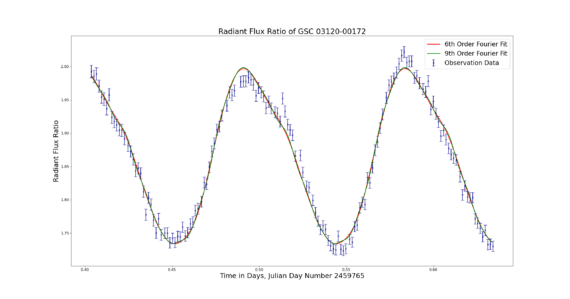Mark Bergmann & Konrad Weber
Using the TURMX observatory in summer of 2022, we were able to observe pulsating stars in the constellation of Lyrae. This region of the night sky was chosen as it stood in zenith around midnight for the observatory in spanish Extremadura during the date of observation. This allowed for a comparatively long observation time. (Though, due to conducting the observations amid summer, no more than six hours of complete darkness were available for such observations).
Two candidates for observation were chosen: GSC 03120-00172, a well-cataloged ‘High-Ampitude-δ-scuti’ , and ASASSN-V J185637.15+264724.3, a ‘RR-Lyrae-Class’ pulsator.
GSC 03120-00172 was observed on the night of the 4th/5th of July 2022. The images were ported to Muniwin – a program for analyzing astronomic data. There – through a process called differential photometry – we were able to extract the stars periodic change in luminosity. We observed a periodic drop in brightness of 13.3% with a period of 2h13´20’’. This compares well to the catalogue data (14,49% and 2h10´55’’ respectively).

ASASSN-V J185637.15+264724.3 was observed on 26th/27th of July 2022. Due to high external temperatures, the cooling of the sensor within the observatory had to be limited to 0°C instead of the usual -10°C. This lead to lower image quality. Images were again ported to Muniwin for photometry. We were able to identify a periodic change in brightness of 21% with a period of 4h23´30’’. Perhaps due to the limited cooling, the measured data is not as close to the catalogue data as it was with GSC 03120-00172. In numbers, the catalogue for ASASSN-V J185637.15+264724.3 has a drop in brightness of 13,71% and a Period of 4h27´21’’.

The field of view of the observation of ASASSN-V J185637.15+264724.3 also contained another variable star. It could be identified as the binary star system ZTF J185737.08+264056.0, whose variability type is categorized as ‘W Ursae Majoris-type eclipsing variables’. These star systems, which almost come in surface contact with each other, also have comparatively short periods of less than a day. For ZTF J185737.08+264056.0 this value is expected to be at 9h39´55”, while the measured data suggests a much shorter duration of only 4h56´21”. This difference stems from the fact that the light curve of these types of variable stars consist of alternating primary and secondary minima, depending on which star currently obscures the other. These minima often are hard to differentiate because of their similar depths. Because of the time frame for the observation, only half a period could be observed. The similarity of depths of the primary and secondary minima causes the fit program to interpret the half period as a full one.


